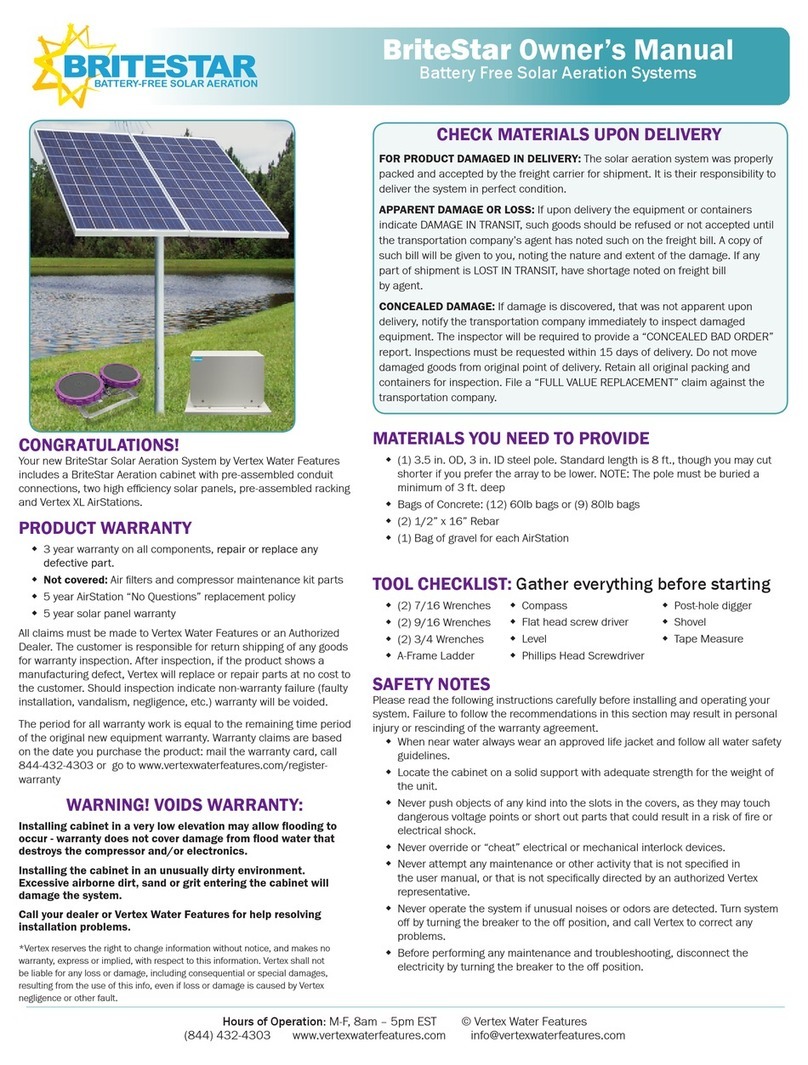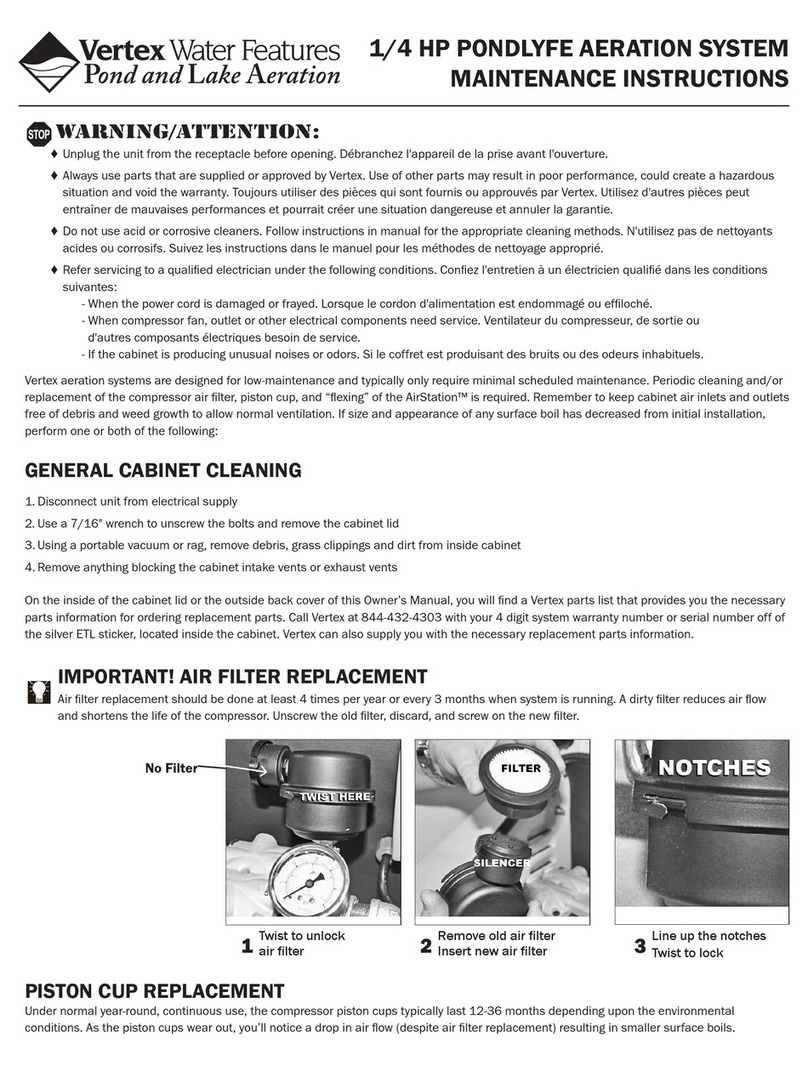Vertex PRO-BIO Installation guide

USING VERTEX PRO-BIO PELLETS FAQ
What is a probiotic m thod?
Probiotics (or Bacterial Driven Systems) describes the utilization of carbon sources to fuel marine
heterotrophic bacteria in order to increase denitrification and the growth of bacterial biomass. In doing
so probiotics allow aquarists to maintain low nutrient levels regardless of dense stocking or heavy
feedings.
Some probiotic systems utilize zeolith medias within reactors to both localize the majority of these
bacteria and provide a source of agitation dislodging the resulting “mulm” (bacterial microfilms) into
the water column. This “mulm” then becomes a source of nourishment for a large assortment of
(sessile) filter feeding animals including corals.
Typical examples of probiotic methods include popular systems such as Zeovit Prodibio NeoZeo VSV
etc.
While there are no guidelines to follow when adding a carbon source to a system
What ar V rt x Pro-Bio P ll ts?
Vertex Pro-Bio Pellets are composed of organic biodegradable polymers. In essence they fulfill the
traditional roles of media and carbon source. Placed in a fluidized reactor they also functionally agitate
and release “mulm” into the water column.
Why us Pro-Bio P ll ts?
As there are no test kits or concrete guidelines to follow when dosing a carbon source into a system the
style has typically been left to only the most advanced and dedicated aquarists to explore. Pro-Bio
Pellets simplify probiotics by automating the daily processes. The polymers being inert take the
guesswork out of dosing as they only break down as bacteria consume them. Properly fluidized the
media is self-agitating.
Things to b awar of
•
There is no replacement for regular maintenance and water changes.
•
Probiotics is not a band-aid to cover up problems. Yes it can help reduce nitrates and algae but
without finding the root of these problems a carbon source will only mask the issue and
complicate it further.
•
Like any change to a delicate closed system Pro-Bio Pellets need to be introduced slowly to
mitigate any shock that the change in environmental factors may cause. This is especially true of
older tanks that have not yet been subject to any bacterial methods.

*Using pellets on a system suffering from “Old Tank Syndrome” (OTS) is not
recommended without a strong understanding of the causation behind the OTS. lease
consult with an expert resource prior to beginning any probiotics.
*
Using pellets to engage a prevalent cyano “red slime” problem is not recommended
without the due diligence of research and preparation. Red slime is actually a bacteria
that can utilize the carbon as a food source.
In order to overcome cyano-related issues, vacuum out as much of the slime as possible.
This should be followed by a series of small daily water changes (5-10%, siphoning out
any visible debris) and an aggressive inoculation of a high quality bacterial additive.
These steps help to reduce the biomass of the cyano while allowing for more beneficial
strains of bacteria to establish themselves prior to the introduction of a labile carbon
source.
*Ensure that all your water parameters are within Natural Salt Water (NSW) levels prior
to using ro-Bio ellets:
Salinity 1.023 – 1.025
Ca 375 – 450 ppm
Mg 1300-1400 ppm
K 380 – 400 ppm
dkH 7.0 – 8.0
pH 8.0 – 8.3
*When starting newer tanks, follow the directions on the packaging. When introducing
pellets to an established system, start with 10-25% of the recommended pellet volume.
Always inoculate the pellets with a high quality bacterial additive. Failure to properly
seed may lead to low efficacy.
Starting Out
1. Pay careful attention to all the preparations as stated above.
2. Determine the Net water volume of your system (total water volume minus rock and
substrates).
3. Start with a tall media reactor rated to or larger than your water volume. Media reactors that
allow for high flow are ideal. Do not use any sponges within your media filters they will clog
with bacterial films and restrict flow. Plastic mesh screens are recommended.
4. Measure out 25-50% of the recommended pellet volume for your system and thoroughly rinse it
off with warm water. Allow pellets to soak in water overnight.
5. Add the pellets to your reactor and adjust the flow through the reactor so that the entire
column is fluidized (take care not to let any pellets escape the reactor).
6. Add your bacterial solutions. For the first week you will want to inoculate the pellets rather
aggressively (double the dosing/frequency).
7. Observe your tank for changes in nutrient levels and/or drops in algae densities.

8. Once a clear trend of declining nutrients/algae begins you may start slowly adding more pellets
to the reactor until you reach the recommended use volumes (500 mL/100 gallons of net water
volume).
9. Top of the pellets as the bacteria consume them.
10. Occasional adjustments to the flow rate may be required over time to compensate for the
changes to pellet volumes (bacterial metabolism or pellet additions).
11. The occasional inoculation of bacteria is recommended. Once every three – four months is ideal.
Troubl shooting
1. My water has turned cloudy.
Cause - A sudden introduction of a carbon source is being exploited by bacteria other than the
beneficial heterotrophic strains resulting in an opaque “bloom”. This bloom is generally
harmless though you may see a sudden drop in ORP levels.
Solution – Temporarily remove or reduce the pellets from the system. These can be cleaned and
stored until the system is ready. Begin aggressively inoculating the system with desirable strains
of bacteria to “out compete” those causing the bloom. Once the water clears up slowly resume
the pellet regime.
2. My cyano or algae problems have become worse after using the pellets.
Cause - Other problem organisms are exploiting the sudden influx of carbon food sources.
Solution – As with the above bacterial bloom temporarily remove or reduce the pellets from the
system. These can be cleaned and stored until the system is ready. Begin aggressively
inoculating the system with desirable strains of bacteria to “out compete” the cyano or algae.
Resume pellets once the problem has cleared up.
3. I have been running the pellets for several weeks and have yet to notice any results.
Cause – Assuming properly inoculation the heterotrophic bacteria are not becoming properly
established within the system. This may be caused by the use of copper-based medications
ozone UV sterilizers phosphate binding medias or extremely large and frequent water changes.
Solution – Remove any of these retardants to ensure that the medias are becoming properly
established.
4. My pellets are clumping.
Cause – Not enough flow or pellets were not properly cleaned prior to use.
Solution – Increase the flow through the reactor and make sure to clean the pellets with warm
water along with an overnight soaking prior to use.
Occasionally the pellets will require a few weeks of tumbling to build up bacterial films before
they become fully fluid.
Table of contents
Other Vertex Lawn And Garden Equipment manuals
Popular Lawn And Garden Equipment manuals by other brands

Sunforce
Sunforce SOLAR user manual

GARDEN OF EDEN
GARDEN OF EDEN 55627 user manual

Goizper Group
Goizper Group MATABI POLMINOR instruction manual

Rain Bird
Rain Bird 11000 Series Operation & maintenance manual

Cub Cadet
Cub Cadet BB 230 brochure

EXTOL PREMIUM
EXTOL PREMIUM 8891590 Translation of the original user manual

GHE
GHE AeroFlo 80 manual

Land Pride
Land Pride Post Hole Diggers HD25 Operator's manual

Yazoo/Kees
Yazoo/Kees Z9 Commercial Collection System Z9A Operator's & parts manual

Premier designs
Premier designs WindGarden 26829 Assembly instructions

Snapper
Snapper 1691351 installation instructions

Mosquito Magnet
Mosquito Magnet Patriot Operation manual








